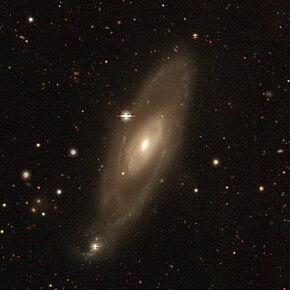Spiral galaxy in the constellation Aries
NGC 1024 is a large spiral galaxy of type Sab located in the constellation Aries . Its speed relative to the cosmic microwave background is 3,306 ± 16 km/s, which corresponds to a Hubble distance of 48.8 ± 3.4 Mpc (~159 million light-years). NGC 1024 was discovered by German-British astronomer William Herschel in 1786.
NGC 1024 was used in the Atlas of Peculiar Galaxies
The luminosity class of NGC 1024 is I-II and it has a broad HI line. With a surface brightness equal to 14.02 mag/am^2, we can qualify NGC 1024 as a low surface brightness (LSB) galaxy . LSB galaxies are diffuse (D) galaxies with a surface brightness less than one magnitude lower than that of the ambient night sky .
To date, five non-redshift measurements yield a distance of 46.260 ± 3.155 Mpc (~151 million ly), which is within the Hubble distance range.
NGC 1024 Group
NGC 1024 is the largest and brightest of a small group of three galaxies named after it. The other two galaxies in the NGC 1024 group are NGC 990 and NGC 1029 . On the other hand, NGC 1024 and NGC 1029 form a pair of galaxies.
See also
External links
References
"Data from revised NGC and IC Catalogue by Wolfgang Steinckle, NGC 1000-1099" . astrovalleyfield.ca . Retrieved 2024-06-06."NASA/IPAC Extragalactic Database results for NGC 1024" . ned.ipac.caltech.edu . Retrieved 2024-06-06.^ "New General Catalog Objects: NGC 1000 - 1049" . cseligman.com . Retrieved 2024-06-06.
"NED Distance Results for NGC 1024" . ned.ipac.caltech.edu . Retrieved 2024-06-06.Garcia, A. M. (1993-07-01). "General study of group membership. II. Determination of nearby groups" . Astronomy and Astrophysics Supplement Series . 100 : 47–90. ISSN 0365-0138 .
Mahtessian, A. P. (1998-07-01). "Groups of galaxies. III. Some empirical characteristics" . Astrophysics . 41 : 308–321. doi :10.1007/BF03036100 . ISSN 0571-7256 .
Categories :
Text is available under the Creative Commons Attribution-ShareAlike License. Additional terms may apply.
**DISCLAIMER** We are not affiliated with Wikipedia, and Cloudflare.
The information presented on this site is for general informational purposes only and does not constitute medical advice.
You should always have a personal consultation with a healthcare professional before making changes to your diet, medication, or exercise routine.
AI helps with the correspondence in our chat.
We participate in an affiliate program. If you buy something through a link, we may earn a commission 💕
↑
 Legacy Surveys image of NGC 1024
Legacy Surveys image of NGC 1024